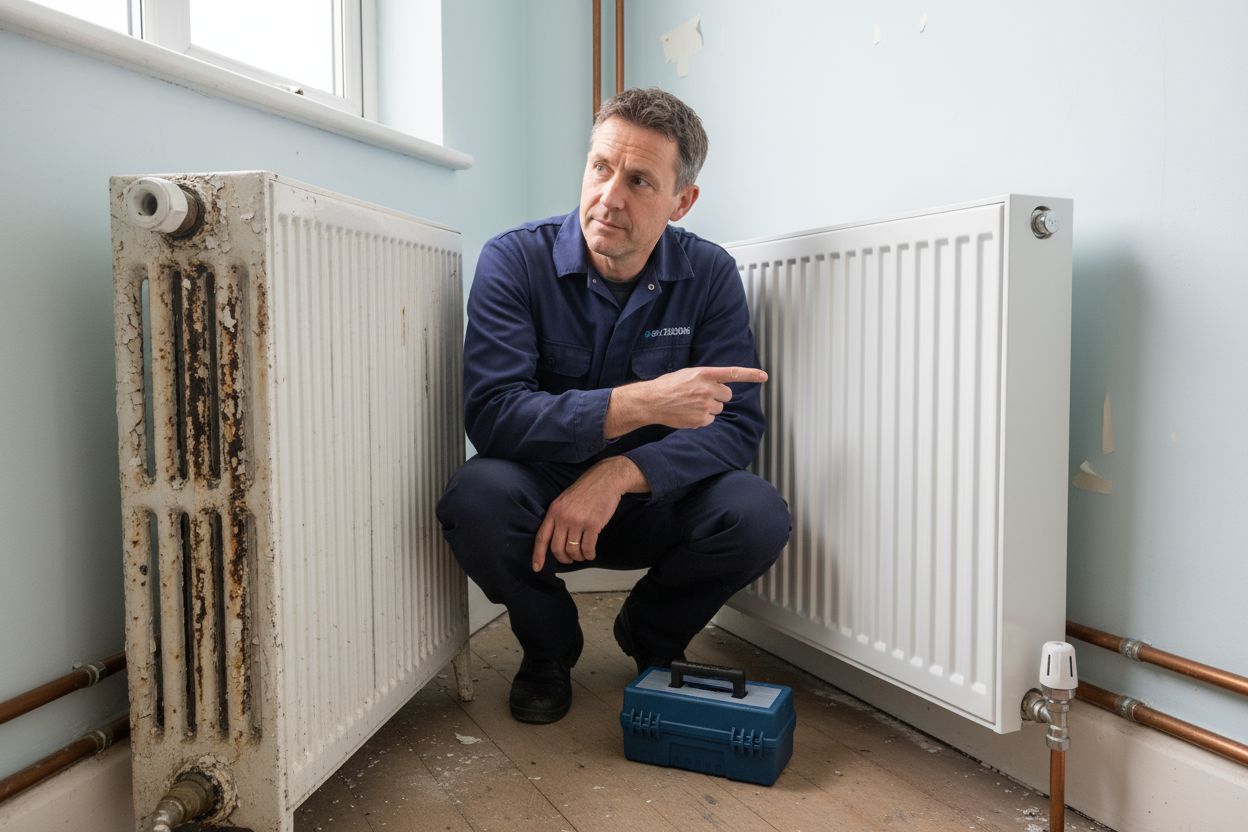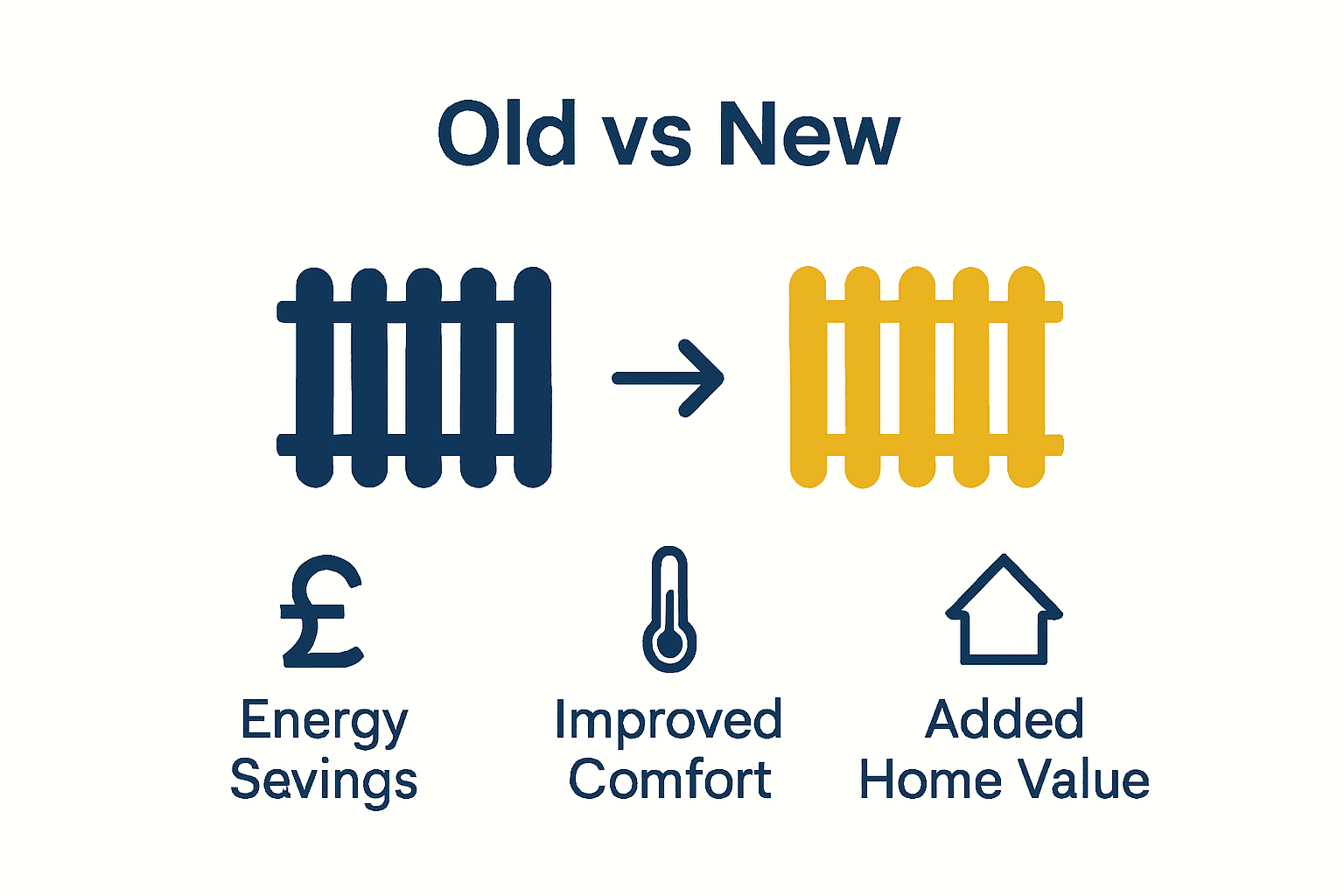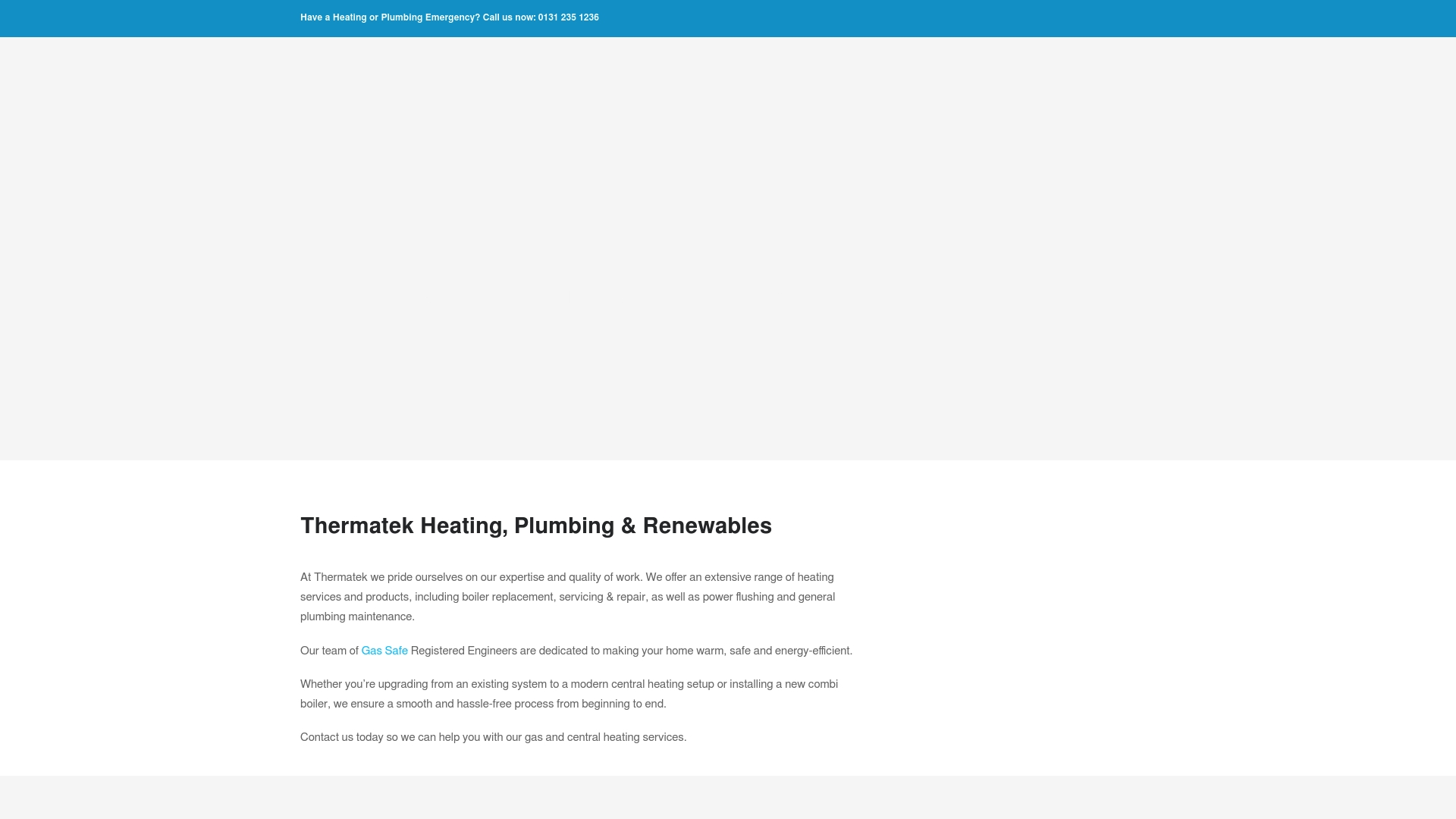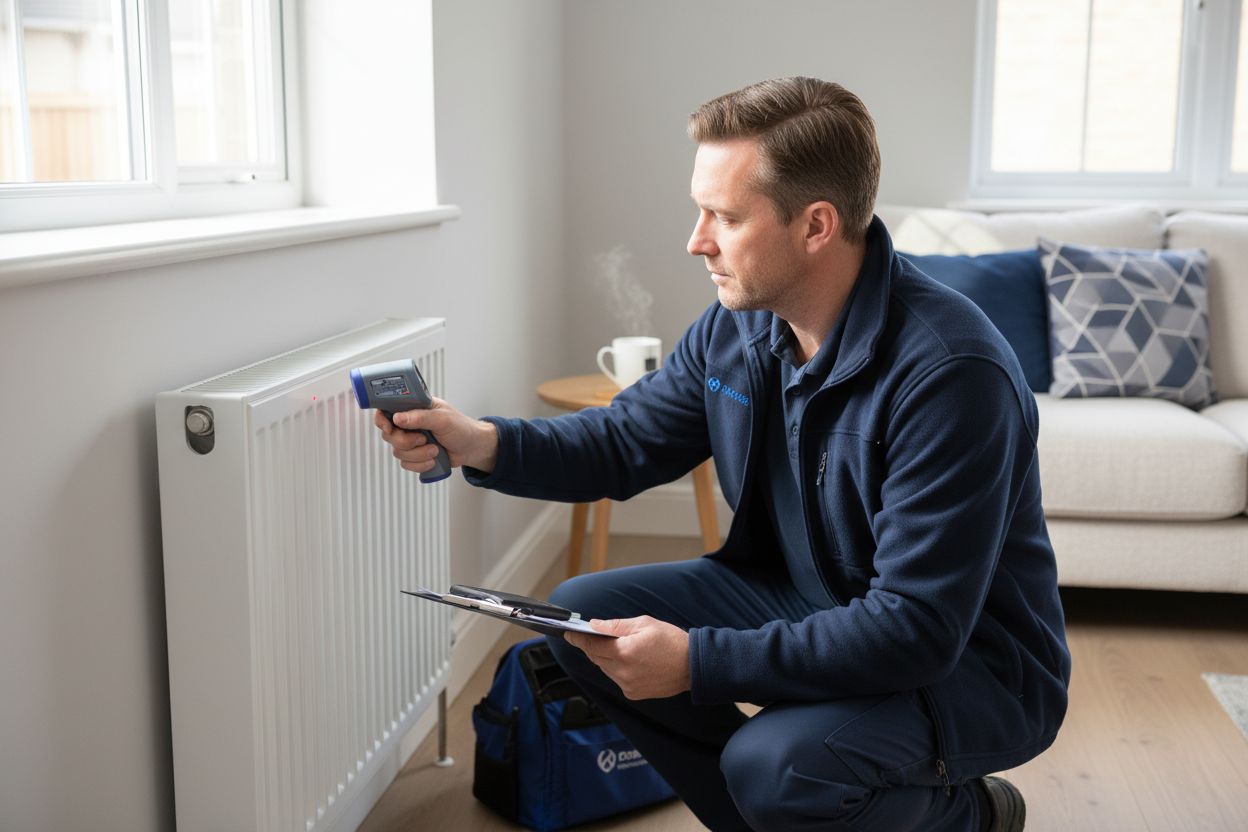Complete Guide to When to Replace Radiators
Did you know that neglected radiators can increase heating bills by up to 30 percent each year? Many households overlook how much their heating system impacts comfort and costs. From misunderstood radiator myths to the latest efficiency upgrades, learning the truth about these essential devices can help you avoid unnecessary expenses, fix common problems, and create a warmer, more cost-effective home.
Key Takeaways
| Point | Details |
|---|---|
| Radiator Functionality | Modern radiators provide efficient heating with advanced features like thermostatic control, improving comfort and energy efficiency. |
| Signs for Replacement | Key indicators such as cold spots, leaks, and unusual noises suggest it’s time to replace your radiator to avoid higher energy costs. |
| Types and Lifespan | Different radiator types vary significantly in lifespan and performance, emphasizing the importance of matching the type to your heating needs. |
| Upgrading Benefits | Upgrading radiators enhances energy efficiency and home value, ultimately leading to lower utility bills and improved comfort. |
Table of Contents
- What Radiators Do And Common Myths
- Warning Signs Your Radiator Needs Replacing
- Typical Lifespan And Types Of Radiators
- Benefits Of Upgrading Old Radiators
- Costs, Timing, And Uk Safety Regulations
What Radiators Do and Common Myths
Radiators are more than just metal panels mounted on walls – they’re sophisticated heating systems designed to distribute warmth efficiently throughout your home. Thermostatic radiator valves (TRVs) play a crucial role in this process, allowing precise temperature control by automatically adjusting hot water flow as rooms warm up. Discover how radiator systems work and you’ll appreciate the engineering behind home heating.
Contrary to popular belief, radiators aren’t simply passive heat emitters. According to research from heating technology experts, modern radiators – including electric models – have evolved significantly. The myth that electric radiators are slow to heat or environmentally unfriendly is rapidly being debunked by advanced designs featuring:
- Rapid convection technology
- Smart temperature regulation
- Energy-efficient heating mechanisms
- Compatibility with renewable energy sources
Understanding radiator functionality helps homeowners make informed decisions about heating. Whether you have traditional water-based radiators or newer electric models, each system has unique advantages. The key is matching your specific home requirements with the right heating technology, ensuring optimal comfort, efficiency, and environmental responsibility.
Warning Signs Your Radiator Needs Replacing
Radiator deterioration isn’t always obvious, but certain warning signs can indicate it’s time for a replacement. Cold spots, unusual noises, and inconsistent heating are red flags that shouldn’t be ignored. Learn about common radiator problems before they escalate into more expensive repairs.
Some critical signs that suggest your radiator might be nearing the end of its functional life include:
- Persistent cold spots preventing even heat distribution
- Frequent leaks around radiator connections or body
- Unusual gurgling or banging sounds during heating cycles
- Excessive rust or corrosion on radiator surfaces
- Rising energy bills indicating reduced heating efficiency
Age is another crucial factor in radiator replacement. Most radiators have a serviceable lifespan of 10-15 years. Beyond this point, they become increasingly inefficient and prone to performance issues. Proactive replacement can save you money on energy costs and prevent unexpected heating system failures. Modern radiators offer improved heat distribution, better energy efficiency, and more sophisticated temperature control mechanisms.
Typical Lifespan and Types of Radiators
Radiators come in various types, each with unique characteristics and expected lifespans. Traditional cast iron radiators can last up to 50 years, while modern steel panel radiators typically serve efficiently for 10-15 years. Learn how to maintain your radiators to maximize their longevity and performance.
The main types of radiators homeowners encounter include:
- Steel panel radiators: Most common, affordable, lightweight
- Cast iron radiators: Extremely durable, excellent heat retention
- Aluminium radiators: Rapid heat transfer, energy efficient
- Electric radiators: Flexible installation, no plumbing required
- Horizontal radiators: Standard wall-mounted design
- Vertical radiators: Modern aesthetic, space-saving option
Factors influencing radiator lifespan extend beyond material. Water quality, maintenance frequency, installation precision, and overall heating system design significantly impact how long a radiator will function effectively. Regular servicing, annual power flushing, and addressing minor issues promptly can extend a radiator’s useful life by several years, preventing premature replacement and reducing long-term heating costs.

Here’s a comparison of popular radiator types and their key attributes:
| Radiator Type | Typical Lifespan | Main Advantages |
|---|---|---|
| Steel Panel | 10-15 years | Affordable Lightweight Commonplace |
| Cast Iron | Up to 50 years | Extremely durable Excellent heat retention |
| Aluminium | 15-20 years | Rapid heat transfer Energy efficient |
| Electric | 15-20 years | Flexible install No plumbing required |
| Horizontal | 10-20 years | Standard design Wall-mounted |
| Vertical | 10-20 years | Space-saving Modern aesthetic |
Benefits of Upgrading Old Radiators
Radiator upgrades represent more than just a cosmetic change – they’re a strategic investment in your home’s comfort and efficiency. Learn about central heating upgrades to understand the full potential of modern heating systems. Modern radiators offer substantial improvements over older models, delivering tangible benefits across multiple dimensions.
The key advantages of upgrading your radiators include:
- Enhanced energy efficiency: Reducing monthly heating costs
- Improved heat distribution: More consistent room temperatures
- Advanced temperature control: Smart thermostatic features
- Reduced carbon footprint: Lower energy consumption
- Sleeker design options: Contemporary aesthetic choices
- Improved home value: Modern heating systems attract potential buyers
Beyond immediate comfort, radiator upgrades contribute to long-term household economics. Newer models use advanced materials like aluminium and incorporate sophisticated heat transfer technologies, which can decrease energy consumption by up to 30%. This means lower utility bills, reduced environmental impact, and a more comfortable living environment. The initial investment in upgraded radiators pays dividends through improved performance, reliability, and potential increases in property value.

Costs, Timing, and UK Safety Regulations
Radiator replacement involves careful consideration of financial investment, optimal timing, and compliance with stringent UK safety regulations. Understand boiler installation regulations to ensure your heating system meets all legal requirements. The total cost of replacement can vary significantly depending on several critical factors.
Typical cost considerations for radiator replacement include:
- Material costs: £100-£500 per radiator
- Labour charges: £150-£250 per day
- Additional system modifications: £200-£800
- Removal and disposal of old radiators: £50-£150
- Potential plumbing adjustments: £100-£300
UK safety regulations mandate that all radiator installations must be performed by Gas Safe Registered engineers. This ensures proper installation, system compatibility, and adherence to Building Regulations Part L, which governs domestic heating efficiency. Homeowners should plan replacements during moderate weather seasons – typically late spring or early autumn – to minimize disruption and allow for comprehensive system testing. While upfront costs might seem substantial, professional installation guarantees long-term performance, energy efficiency, and compliance with national safety standards.
Ready to Upgrade Your Heating? Choose Proven Comfort and Efficiency
If your home is plagued by cold spots, strange noises, or rising energy bills, these are signs your radiator system is letting you down. Ageing radiators often mean inconsistent warmth and wasted energy. Delaying a replacement can lead to even bigger problems when you need your heating most. The article explains how modern radiator systems and smart controls can help you enjoy reliability and lower costs, giving you peace of mind every winter.

Let our Gas Safe Registered engineers at Thermatek Heating replace your old radiators and upgrade your comfort. We specialise in safe, energy-efficient solutions that fit your home perfectly. Discover how easy it is to make your system more efficient, compliant, and ready for future savings. Request your free quote today and take the first step towards a warmer, safer, and more cost-effective home.
Frequently Asked Questions
When should I consider replacing my radiators?
If you notice persistent cold spots, unusual noises, leaks, or excessive rust on your radiators, it’s time to consider replacement. Additionally, if your radiators are over 10-15 years old, upgrading may improve efficiency and comfort.
How can I tell if my radiator is inefficient?
Signs of inefficiency include cold spots that indicate uneven heat distribution, rising energy bills, and unusual sounds like gurgling or banging during operation. These may suggest your radiator isn’t performing as it should.
What are the benefits of upgrading to modern radiators?
Upgrading to modern radiators offers enhanced energy efficiency, improved heat distribution, advanced temperature control, and potential increases in home value. New models can also reduce your carbon footprint by consuming less energy.
How long do different types of radiators typically last?
Steel panel radiators usually last 10-15 years, while cast iron models can endure up to 50 years. Aluminium and electric radiators typically have a lifespan of 15-20 years, depending on maintenance and installation quality.

